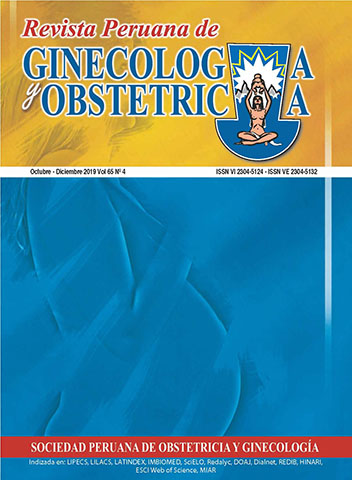Factores asociados a embarazo clínico en inseminación intrauterina
DOI:
https://doi.org/10.31403/rpgo.v65i2201Resumen
Introducción. La inseminación intrauterina es parte de las estrategias del manejo inicial en parejas con infertilidad. Su efectividad en la búsqueda de embarazo ha sido poco investigada y conocida en nuestro país, por lo que es importante definir los grupos de pacientes, indicaciones y condiciones asociadas a una mayor tasa de embarazo clínico. Objetivo. Definir los factores asociados a embarazo clínico en la inseminación intrauterina. Métodos. Estudio retrospectivo de 633 parejas con diagnóstico de infertilidad atendidas en el Centro de Fertilidad y Ginecología del Sur, Cusco, Perú. Se realizaron 1 053 ciclos de inseminación intrauterina, en ciclos espontáneos o asociados a estimulación ovárica, con inseminación doble o simple, inseminación pre o post ovulatoria, con muestra de semen del cónyuge capacitada por swim-up o por gradientes de densidad. Resultados. La tasa de embarazo clínico fue 8,2% por ciclo de inseminación y 13,6% por pareja. Los factores con mayor asociación al embarazo clínico fueron: contar con 2 folículos o más (OR: 2,873), lograr la inseminación sin dificultad (OR: 2,341), tener 3 años o menos de infertilidad (OR: 2,240), el factor cervical como indicación (OR: 2,194), uso de gonadotropinas (OR: 1,846) y edad de la mujer menor a 38 años (OR: 1,819). Conclusiones. La inseminación intrauterina logró una tasa de embarazo clínico aceptable en nuestro estudio, requiriendo ser acompañada de una adecuada selección y preparación de las parejas.Descargas
Los datos de descargas todavía no están disponibles.
Descargas
Publicado
2019-10-02
Cómo citar
Vargas-Tominaga, L., Alarcón, F., Vargas, A., Medina, A., Vargas, A., Gómez, M., Escobedo, D., & Gallegos, M. (2019). Factores asociados a embarazo clínico en inseminación intrauterina. Revista Peruana De Ginecología Y Obstetricia, 65(4), 437–442. https://doi.org/10.31403/rpgo.v65i2201
Número
Sección
Artículos Originales
















